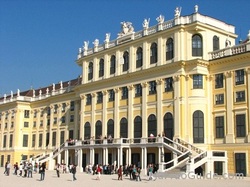History

A picture of the Congress of Vienna
Celtic people from prehistory inhabited the Austrian area until the area fell to Rome in 1st Century B.C. The, in the 2nd Century, Slavs, Germans, Huns and Bohemians entered and began to settle in the area. In the 9th century, Hungarians advanced westward along the Danube river and occupied Austria, only to be defeated by the German King Otto 1 at the battle of Lech in 955 though. Otto established a protective zone along the border to control eastern tribes. Otto 2 then gave the area to a Bavarian nobleman, Leopold of Babenberg to keep the Hungarians at bay. The Babenberg dynasty ended in 1246, which is when a holy Roman emperor, Rudolf of Habsburg took control in 1278, beginning his 640 year dynasty. In which, the land expanded greatly taking surrounding countries, including Northern Italy, Spain, parts of Germany, and even American territories. In the 17th Century, the Ottoman Empire launched two attacks on Austria, one in 1529, the other in 1683, but both failed. With the death of Charles 6 in 1740, his daughter Maria Theresa took control, and reigned over a golden age for forty years. She later ruled jointly with her son, Joseph 2, beginning in 1765. Their rule began to transform Austria into a modern state, establishing centralized control of state, civil service, public service, legal systems and expanded industries and reformed the military. During the French Revolution and Napoleon’s rise to power, Austria weakens. In addition, to expand, France declares war on Austria in 1792 and captures Habsburg territory. The Austrian emperor at the time, Franz 2, with Britain, Prussia and Russia fight the French. With the congress of Vienna in 1814-1815, they planned a permanent settlement of European territorial boundaries. The congress created the German confederation, which was a union of 39 small German states, with Austria in control. This made Austria one of the central powers of Europe. German Nazi soldiers then annexed Austria in 1938. After the war, the allies divided Austria into 4 sections, weakening the annexation by Germany in 1945. Then allies re-established Austria as independent Republic under constitution. It wasn’t until the State Treaty in the October of 1955 that the U.S., Britain, France, and the Soviet Union ended their occupation of Austria. Thus Austria remains a neutral state today. (Griffin)
Major Cities Today

Vienna is a major river port along the Danube River and therefore one of the most populated cities in Austria today. Vienna is the capitol of Austria and has many interesting areas, which tell of its history. For example, the KunsthistorischesMuseum, which show cases the finest collections of art and even art created for the Habsburg emperors. There is also the SchonbrunnPalace, which has been placed on the UNESCO world cultural heritage list. In Vienna, there is also the very famous, Tiergarten Schönbrunn. (Austria)

Innsbruck is the capitol of the Federal state Tirol. Mountains surround it, Nordkette in the north, Patscherkofel and Serles in the south. Innsbruckis situated over the Brenner Pass, making it an important route, and therefore the city flourished. (Austria) Innsbruck is international known for being a Winter sports center. Innsbruck held the 1964, 1976 Winter Olympics, and the 1984 and 1988 Winter Paralympics. (Wikipedia) Innsbruck is also famous for it's Golden Roof. The Golden Roof was built by Archduke Friedrich IV in the early 15th century for Emperor Maximilian so he could sit and watch the tournaments being held in the square. (Wikipedia) The Golden Roof was built for Emperor Maximilian, to honour his second marriage to Bianca Maria Sforza of Milan. (Wikipedia)

Salzburg lies on the river of Salzach, which is the main reason the it became such a populated city. (Wikipedia) Salzburg is the city in which Mozart was born in, bringing a lot of tourism towards the city. Salzburg is also the capitol of the federal state of Salzburg. (Austria) Salzburg has been dubbed, "Old Town", and for good reason. Salzburg is famous for the very prominent Baroque architecture which has been kept in the town until the this day. (Wikipedia) Salzburg has also been placed on the UNESCO world heritage list like Vienna. (Wikipedia)
